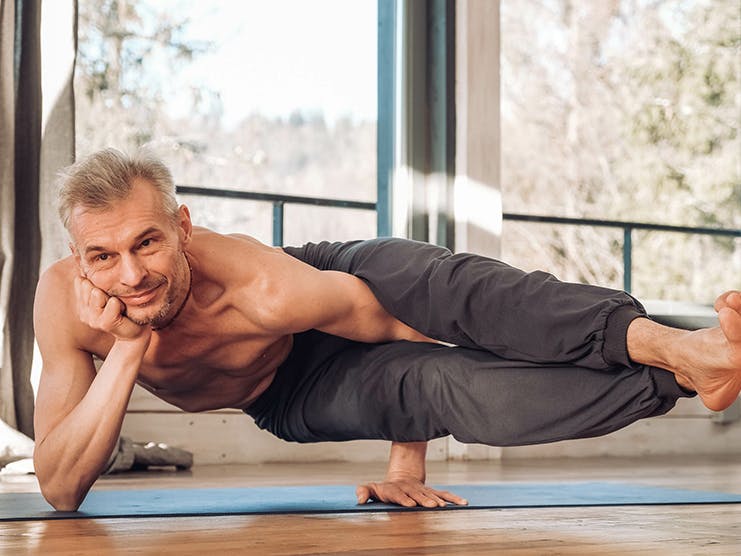
When you think of fitness, you probably think of strength and cardiovascular health. What you may not think about is balance. But good balance is an important component of health, particularly for older people. It can help with mobility, posture, and muscle tone.
Just as important, improved balance can help prevent falls.
As you age, your risk of falling increases. According to the CDC, about 3 million older people are treated in the emergency room for fall injuries each year, and 300,000 of them are admitted for hip fractures.
Although you don’t consciously think about it, maintaining your balance is a complex skill.
“There are several components of the nervous system, as well as motor or movement functions, that need to be intact,” Dr. David Thurman, a neurologist and spokesman for the American Academy of Neurology, explained to The New York Times. “All of these tend to degrade with age, particularly as people move into their seventh and eighth decades.”
Unfortunately, not only are older adults more likely to fall, the consequences of these falls are often far more serious. In fact, a third of adults over 50 who suffer a hip fracture die within one year. Clearly, avoiding a fall is in your best interest!
Your risk of falling
From medicinal side effects to common diseases, there are several factors that contribute to fall risks in older adults.
- Impaired vision. Common eye conditions in older adults, like cataracts and glaucoma, can alter your depth perception and visual clarity, putting you at greater risk of trips and falls.
- Declining physical fitness. Many adults exercise less as they get older, which worsens their muscle strength, balance, bone density, coordination, and flexibility.
- Medication side effects. A lot of medications — including certain pain and thyroid medications, supplements, and anticoagulants — can cause dizziness, drowsiness, and low blood pressure.
- Chronic illnesses. Conditions like Parkinson’s and Alzheimer’s disease, multiple sclerosis, and arthritis can affect both balance and gait.
- Dehydration. Many people don’t know how much water they should be drinking in a day. Dehydration can lead to dizziness, a drop in blood pressure, and falls.
It’s important to talk to your doctor to find out your risk of falling and whether there are steps you can take to reduce it, like a medication adjustment.
Balance exercises
Your doctor may recommend exercises you can do to improve your balance and stability. Sometimes the simplest exercises are best. Start slow and use support. Hold on to a wall or other steady structure if alone, or have someone spot you.
- Shift weight from one leg to the other. It sounds easy enough, but this simple movement helps strengthen the muscles in the legs and improve balance. It’s also a useful test for how good your balance actually is.
- Stand on one leg. If you’re okay with shifting your weight, try to fully stand on just one leg. The activity strengthens ankles, engages your core, and improves overall balance.
- Learn tai chi. Often described as meditation in motion, tai chi is practiced with deep breathing and slow, focused movements. The practice improves balance by targeting the components involved in staying upright — range of motion, reflexes, leg strength, and flexibility.
- Walk the imaginary tightrope. Walk heel to toe in a straight line with slow, controlled movements. Extend your arms out to your sides if you need extra help with balance. Don’t look down — keep your eyes on the horizon!
- Practice rear leg raises. Hold a wall or chair with both hands. Slowly raise one leg backwards. Hold the position for a few seconds and then return. Do 10 to 15 repetitions for each leg, making sure not to hyperextend. This movement will strengthen your lower back and buttocks.
- Do toe stands. Stand and hold the back of a chair or wall with both hands. Raise your heels off the floor so you’re on your tiptoes. Hold the position for about 10 to 15 seconds. See if you can let go with one or both hands. Then release back down to the floor.
- Practice yoga. There are many types of yoga, and all of them help to improve balance. Gentle yoga, slow flow, and chair yoga are great options for older adults who are just beginning their yoga journey. DoYogaWithMe is a yoga website that has hundreds of online classes, ranging from beginner to advanced. And many of the courses are completely free.
If you’re unsure of where to start when it comes to these exercises, be sure to talk to your doctor or a certified fitness instructor. Start slow. No matter where you begin, be consistent and watch as your balance improves and develops!
Wondering what Medicare covers?
It’s no surprise that Medicare covers medical expenses. But some Medicare Advantage plans will provide coverage for household help while you recover and rides to doctor’s appointments. What’s more, some Advantage plans offer benefits that can help prevent falls to begin with! Look for plans that provide coverage for exercise programs and vision care.
Additional Resources
Does Medicare Cover Gym Memberships?
Internal Website Link
Free Online Exercises for Older Adults
Internal Website Link
7 Surprising Medicare Advantage Benefits
Internal Website Link


